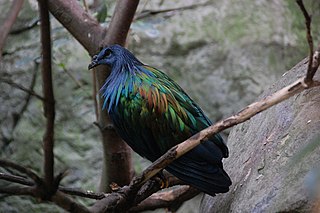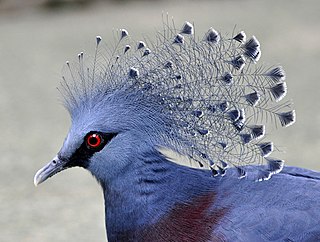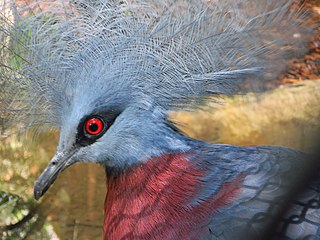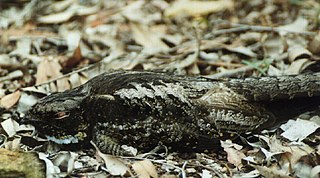
Columbidae is a bird family consisting of doves and pigeons. It is the only family in the order Columbiformes. These are stout-bodied birds with short necks and short slender bills that in some species feature fleshy ceres. They primarily feed on plants, and can be taxonomically divided amongst granivores, that feed mostly on the ground on seeds, and frugivores, that feed mostly on fruits, from branches. The family occurs worldwide, often in close proximity with humans, but the greatest variety is in the Indomalayan and Australasian realms.

The true parrots are about 350 species of hook-billed, mostly herbivorous birds forming the two superfamilies Psittacidae, and Psittaculidae, two of the three superfamilies in the biological order Psittaciformes (parrots). True parrots are widespread, with species in Mexico, Central and South America, sub-Saharan Africa, India, Southeast Asia, Australia, and eastwards across the Pacific Ocean as far as Polynesia. The true parrots include many of the familiar parrots including macaws, conures, lorikeets, eclectus, Amazon parrots, grey parrot, and budgerigar. Most true parrots are colourful and flighted, with a few notable exceptions.

The family Cisticolidae is a group of about 160 warblers, small passerine birds found mainly in warmer southern regions of the Old World. They were formerly included within the Old World warbler family Sylviidae.

The Nicobar pigeon or Nicobar dove is a bird found on small islands and in coastal regions from the Andaman and Nicobar Islands, India, east through the Indonesian Archipelago, to the Solomons and Palau. It is the only living member of the genus Caloenas alongside the extinct spotted green pigeon and Kanaka pigeon, and is the closest living relative of the extinct dodo and Rodrigues solitaire.

The Luzon bleeding-heart, bleeding-heart dove, bleeding-heart pigeon or punay is one of a number of species of ground dove in the genus Gallicolumba that are called "bleeding-hearts". The native name in Tagalog is punay. It is also known as paloma de punalada 'stabbed pigeon'. The Luzon Bleeding-heart is the species in which the "blood" feature is most pronounced, with the reddish hue extending down the belly, furthering the illusion of blood having run down the bird's breast.

The Mindoro bleeding-heart, also referred to as kulo-kulo, la-do, manatad, manuk-manuk, punay, and puñalada by the Mangyan, is a species of ground dove native solely to the island of Mindoro in the Philippines. It is critically endangered and threatened by habitat loss largely motivated by marble extraction. Due to its biological line and its survival status, it has been listed as an EDGE species by the Zoological Society of London.

The Negros bleeding-heart pigeon is endemic to the Philippines where it is found on the islands of Negros and Panay. It is critically endangered; continuing rates of forest loss on the two islands where it occurs suggest that it will continue to decline. The population is estimated to be just 50 - 249 mature individuals. The species has an extremely small, severely fragmented population. The bird is listed as an EDGE species under the analysis of the Zoological Society of London.

The crowned pigeons (Goura) is a genus of birds in the family Columbidae. It contains four large species of pigeon that are endemic to the island of New Guinea and a few surrounding islands. The species are extremely similar to each other in appearance, and occupy different regions of New Guinea. The genus was introduced by the English naturalist James Francis Stephens in 1819.

The western crowned pigeon, also known as the common crowned pigeon or blue crowned pigeon, is a large, blue-grey pigeon with blue lacy crests over the head and dark blue mask feathers around its eyes. Both sexes are almost similar but males are often larger than females. It is on average 70 cm (28 in) long and weighs 2.1 kg (4.6 lbs).

Scheepmaker's crowned pigeon is a large, terrestrial pigeon confined to the lowland forests of south eastern New Guinea. It has a bluish-grey plumage with elaborate blue lacy crests, red iris and very deep maroon breast. Both sexes have a similar appearance. It is on average 70 cm (28 in) long and weighs 2,250 grams (5 lbs), making this the second largest living pigeon species behind the Victoria crowned pigeon.

The eared nightjars are a small group of nocturnal birds in the nightjar family, although the taxonomy is uncertain. There are seven species, mainly found in forest and scrub from China to Australia. Five species are placed in the genus, Eurostopodus, the other two species in Lyncornis. They are long winged birds with plumage patterned with grey and brown to camouflage them when resting on the ground. They feed on insects caught in flight. A single white egg is laid directly on the ground and incubated by both adults. The chicks can walk soon after hatching.

The golden fruit dove, also known as the golden dove, lemon dove or yellow dove, is a small, approximately 20 cm (8 in) long, short-tailed fruit-dove in the family Columbidae. The common name refers to the males' bright golden-yellow colour. The body feathers appear almost iridescent due to their elongated shape and hair-like texture. The head is slightly duller with a greenish tinge. The bill, orbital skin and legs are bluish-green and the iris is whitish. The underwings and tail coverts are yellow. The female is a dark green bird with bare parts resembling those of the male. The young resembles the female.

The Sulu bleeding-heart or Tawitawi bleeding-heart is a species of bird in the pigeon and dove family, Columbidae. It is endemic to the island of Tawi-Tawi and its surrounding islets in the Philippines' Sulu Archipelago. This species is known only from two specimens collected in 1891, and has not been recorded with certainty since. It lives in primary and secondary forests that have a closed canopy. The Sulu bleeding-heart is a medium-sized pigeon with a short tail. Bright metallic green feathers stretch from the forehead and crown down to the mantle and sides of the breast, where they surround a large, pale orange breast spot with diffuse edges that gives the species the name "bleeding-heart". The lower wings and back are varying shades of brown, and the throat and chest are largely white. The belly is an ashy-gray.

Stenostiridae, or the fairy flycatchers, are a family of small passerine birds proposed as a result of recent discoveries in molecular systematics. They are also referred to as stenostirid warblers.

The blue pigeons are a genus, Alectroenas, of birds in the dove and pigeon family Columbidae. They are native to islands in the western Indian Ocean.

The barking imperial pigeon, also known as Peale's imperial pigeon, is a species of bird in the pigeon family Columbidae. It is endemic to Fiji, where it occurs on most of the medium and large islands.

The ornate fruit dove is a species of bird in the family Columbidae. It is found in New Guinea. Its natural habitats are subtropical or tropical moist lowland forest and subtropical or tropical moist montane forest.
Apystomyia is a genus of flies in the family Apystomyiidae. The genus contains the single living Apystomyiidae species, Apystomyia elinguis, which is primarily found in California. Details of its life history are largely unknown. The extinct genus Hilarimorphites is known from the Cretaceous Burmese and New Jersey ambers. Formerly placed in the Asiloidea, molecular phylogenetic studies in 2010 placed the genus unambiguously as a sister of the Cyclorrhapha within the clade Eremoneura.

Pampusana is a mid-sized genus of ground-dwelling doves which occur in rainforests in the Pacific region. They are not closely related to the American ground doves.

The fruit doves, also known as fruit pigeons, are a genus (Ptilinopus) of birds in the pigeon and dove family (Columbidae). These colourful, frugivorous doves are found in forests and woodlands in Southeast Asia and Oceania. It is a large genus with over 50 species, some threatened or already extinct.



















